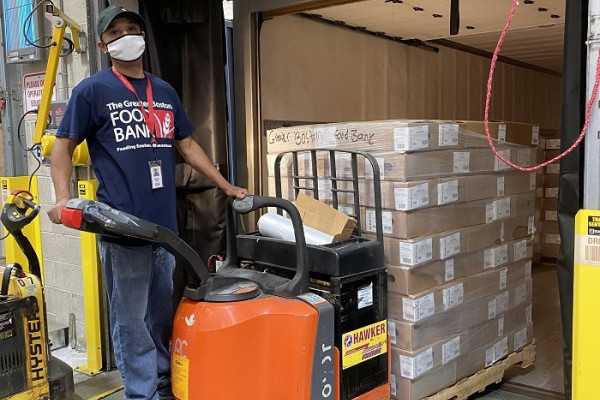
The Greater Boston Food Bank is among several food banks that are pleased to be distributing haddock chowder. Courtesy photo.
By Doreen Leggett
Emily Yerby works for The Greater Boston Food Bank and came home from an “insanely” hard day at work too exhausted to cook dinner. So she threw some haddock chowder on the stove, the same chowder that has been offered at pantries across the state.
“It was perfect,” she said. “This for me has been a silver lining during all this chaos.”
The Cape Cod Commercial Fishermen’s Alliance new haddock chowder first arrived in mid-August and proved popular right away.
“The soup is flying out of the food pantries,” Yerby said.
With a higher than average amount of haddock per serving, the chowder was launched with two key goals; keep fishermen on the water and help feed the hungry.
And the number of people to be served is growing. Yerby ran through the numbers:
Pre-Covid, she said, 1 in 13, or 415,000 people, in eastern Massachusetts, were food insecure. Now it’s 1 in 8, almost 659,000 – a 59 percent increase. Things will likely get worse. Unemployment numbers are expected to increase and the price of groceries has already grown – the number bumped up 2.6 percent in April, the largest increase since 1974.
“It is earth shattering,” Yerby said.
That stark reality is why many are finding haddock chowder, and what it represents, quintessential comfort food.
“Little things matter,” said Adam Gracia, director of development at Cape and Islands Veterans Outreach Center, who is picking up cases weekly for a pantry the non-profit runs. The haddock chowder checks all the boxes, he said. For starters, it is supporting a historic, essential industry.
“Who doesn’t want to help fishermen? When you are on Cape Cod you are inclined to help our fishermen and our environment. These are the things that make Cape Cod special,” he said.
Gracia, who lives in Chatham and buys scallops direct off the boat when he can, sees food as more than sustenance, especially now. It’s a pick-me-up. People respond to how the chowder sustains our community as well as our nutrition, he explained. Knowing that eating the chowder is helping people makes it more appealing, and will prompt them to grab the chowder instead of something canned. That’s pushing them to make better food choices, he said, adding that it is just as quick and easy as a can of chili.
“On a cold crummy day if you are feeling down there is nothing like a warm cup of chowder, it warms the soul,” said Gracia. “The idea of soul food isn’t silly.”
The haddock chowder is also at the cusp of two movements gaining steam: growing recognition of health benefits of eating seafood as well as the goal of eating local.
“There is just an endless amount of research about how good fish is for you,” said Yerby.
The Greater Boston Food Bank works with close to 550 partners. Support for the story behind the chowder has been consistent. In addition to fishermen, the chowder is benefiting the processor, trucking companies, and chowder makers, all based in Massachusetts. The ripple effects are significant, Yerby noted.
“Now they are all doing it to help people in Eastern Mass. who don’t know where their next meal is coming from,” Yerby said. “At the end of the day fishermen want people to get fed.”
Nick Muto, a captain who lives in Orleans, agreed. He recently caught some haddock on George’s Bank, landed it in Chatham and Mac’s Fish and Lobster sent it up to Great Eastern Seafood to be processed, Plenus Group made it into chowder and then it was off to the food pantries.
“This one is a win all around,” Muto said on a recent day as he steamed into port, adding that there was a lot of the fish around.
The steady fair price matters to him, particularly since the small “snapper” haddock used in the chowder don’t look good in a case so they are harder to sell. But what matters more is building awareness and knowledge that there is a great, nutritious protein being caught by small businesses locally that is readily available. Now, much of the catch goes overseas.
“It’s great to have the fish we catch here, stay here,” Muto said. “The more options that we have to sell our fish, and the more options that people have to get a domestically-sourced product the better it is.”
The chowder arrived in the midst of a “perfect storm,” Yerby said, at a moment when there are problems in both the food supply and the food demand chains. The chowder, funded by grant support through Catch Together, MIT Sea Grant and individuals, is a small step to address one component and it resonated.
Yerby said in the pandemic’s early stages they had weekly meetings with partners. The haddock chowder came up and when food pantries across the state began checking off what items they needed, the haddock chowder hadn’t made it on the list yet.
“‘We don’t see the soup!’” Yerby said they chorused. “‘Where is the soup?’”
Once they received it, they put it another order, she said, laughing.
“It’s been very well received,” she said.
Gracia agreed, saying volunteers he works with have been impressed with the taste, the seasoning as well as the reasoning.
“Everyone loves it,” he said. “I am a huge chowder fan. This is a much better traditional chowder. From a palate perspective it will appeal to a broader base.
“It goes back to being a good neighbor, rising tides raise all ships. It is cliché but it’s true,” Gracia said.
